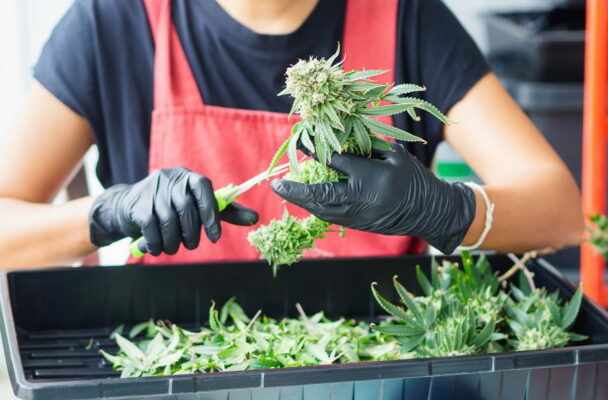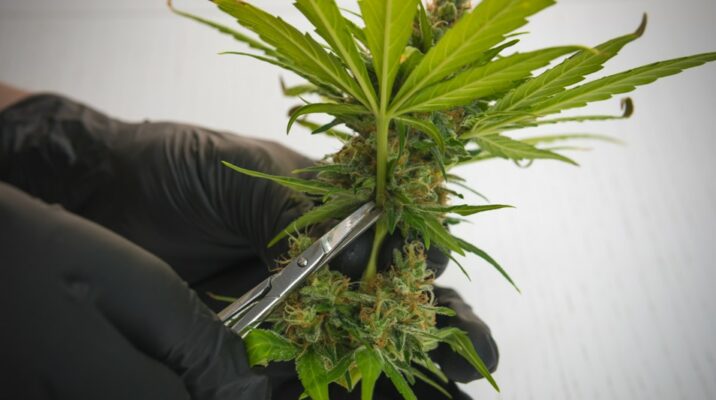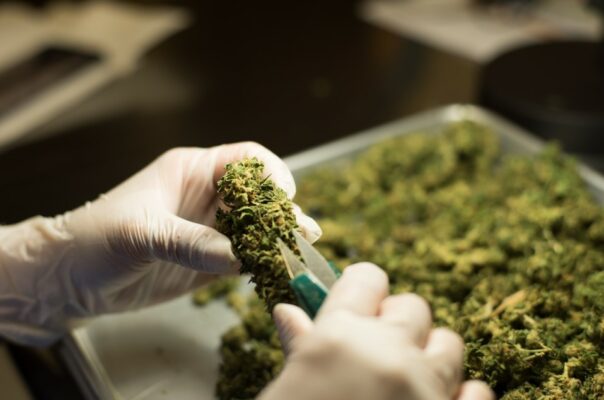Weed trimming should become a part of your weed-growing routine. And there are quite a few reasons supporting this claim. We know that trimming weed might not be the most fun activity out there, but it is a rewarding chore that will pay off in a richer taste and a higher price tag for your buds.
This blog aims to teach when to trim, how to do it like a pro, and when is the best time to manicure your weed flowers.
To Trim or Not to Trim?

Trimming cannabis essentially means removing the sugar leaves, stems, and branches from the buds and leaving the cannabis crop intact. You wouldn’t believe it, but cutting off the remains can actually improve the taste, flavour, and potency of your weed. Perfectly trimmed weed also has a better appearance allowing you to mark up the price.
Trimming sugar leaves is also a good way to reduce the chance of mould formation on your harvested weed buds right before drying. The leaves capture moisture in them and can create a suitable environment for mould to appear. You definitely want to avoid ruining something you’ve spent lots of time and money on.
When it comes to potency, there is really no way trimming can increase the strength of your buds. Although the excess leaves and branches contain no active cannabinoids, drying everything together may reduce the overall potency. If you want to have a concentrated THC level of the bud itself, it’s better to get rid of excess plant material.
The last advantage of weed trimming is the taste. We all want our weed to taste smooth and hit the right spot in our brain, but it’s hard to enjoy a joint when it’s irritating your throat with every puff. So, trimming cannabis equals a smoother taste and a reduction of the harshness of the weed.
Since we’re all on the same page about trimming, our next step is to master the technique of manicuring cannabis.
How to Trim Cannabis: Wet & Dry Trimming
There are two ways of trimming weed: before or after you dry it. Trimming cannabis before drying it is called wet trimming. Conversely, pruning dried weed buds is called dry trimming. Weed growers are divided when it comes to these two techniques. Let’s explore which one is better after all.
What Is Wet Trimming?

Trimming weed buds first thing after harvesting them is referred to as wet trimming. Once branches, leaves, and stems are carefully removed, neatly-stored cannabis buds can be put to drying. It is essential to note that you shouldn’t place a bud on a flat surface because, under its weight, it may lose its tear-drop shape.
When wet trimming, you can start at the bottom of the cannabis bud and meticulously make your way up to the peak of the weed flower. As soon as you are happy with your results and perfectly round, picture-like buds, you can prep them for drying.
Why Wet Trim Cannabis?
One of the reasons growers opt for wet trimming is that they can fit more cannabis buds on a rack. Other benefits include mould prevention and fast drying. So, if you are in a rush to stock up on dry weed, go for wet trimming.
Why Avoid Wet Weed Trimming?
Some growers stay away from wet trimming only because this method incurs a higher cost of labour. Think about it – trimmers get paid by the pound, and foliage holds water that adds up to the total weight.
Pros & Cons of Wet Trimming
| PROS | CONS |
|
|
What Is Dry Trimming?
Pruning cannabis when the buds are fully dried is called a dry trim. Untrimmed buds take a few days longer to dry. The process of trimming is exactly the same when weed flowers are manicured fresh. Trimmers start at the base and work their way to the top, removing sugar leaves and stems. The only problem is that curled leaves may be slightly harder and more time-consuming to trim.
Why Dry Trim Cannabis?
It is believed that when cannabis dries slowly, its flavour remains. Unlike wet trimming, the sap can be released, and some of the flavours can also be lost when leaves are cut fresh.
The flavour isn’t the only advantage of dry trimming. The odour isn’t as hay-like as when you trim fresh buds before drying. This could be due to the longer drying period.
Weed growers opt for a dry trimming method when they aren’t worried about mould formation and grow their cannabis in a low-humid environment.
Why Avoid Dry Weed Trimming?
Only professional trimmers should handle dry trimming. The weed buds are so fragile when fully dried that it’s very easy to remove parts that contain THC and flavour.
Unlike wet-trimmed buds, dry-trimmed buds take up more space, so be ready to free up a room with multiple racks to hand your harvest.
Pros & Cons of Dry Trimming
| PROS | CONS |
|
|
Weed Trimming Tools
Before you get to trimming, you should have:
- Sharp scissors for trimming buds and pruners for cutting big branches
- Disposable gloves
- Clean working space
- Tray or a bowl
How to Hand-Trim Buds?
As mentioned before, dry and wet trimming follow the same step:
- Grab pruners to cut off branches and divide the plant into smaller pieces. If you dry trim cannabis, let it dry for a few days and then proceed to the next step.
- Green foliage has little to no active cannabinoids, so you can cut them off.
- Next is the step to separate buds from the branches. Place buds in a container or a bowl to store them.
- Work on each bud separately. If you end up with big buds, it would be better to break them down into smaller buds for faster drying. Trim the stem, cut the leaves, and remove unnecessary foliage as carefully as possible.
Final Word
Trimming cannabis enhances its flavour, odour, and THC concentration. Whether you do it before or after drying purely depends on your personal preference. The wet and dry trimming has a few distinctions, and weed enthusiasts can’t really choose which one offers a smoothing smoking experience. Some say dry trimming may taste harsher but wet trimming may offer lower THC concentration with other active compounds.
In short, wet trimming prevents mould formation while also speeding up the drying process. On the other hand, dry trimming offers a balanced drying process that preserves the taste and flavour.
If you harvest and dry your weed buds in a room with high humidity, then your best course of action is to wet-trim cannabis. In contrast, you may want to switch to dry trimming if the humidity level is below 45%.
Regardless of which method you choose, make sure you or your trimmers have the proper equipment and try to remove green foliage without damaging the precious bud.
One thought on “Mastering the Art of Weed Trimming”
Leave a Reply
You must be logged in to post a comment.




Hi you all !
Every time i read informations on a product can’t just read one .It is so interesting to learn about product’s you don’t know. Thanks à lot for the infosssss